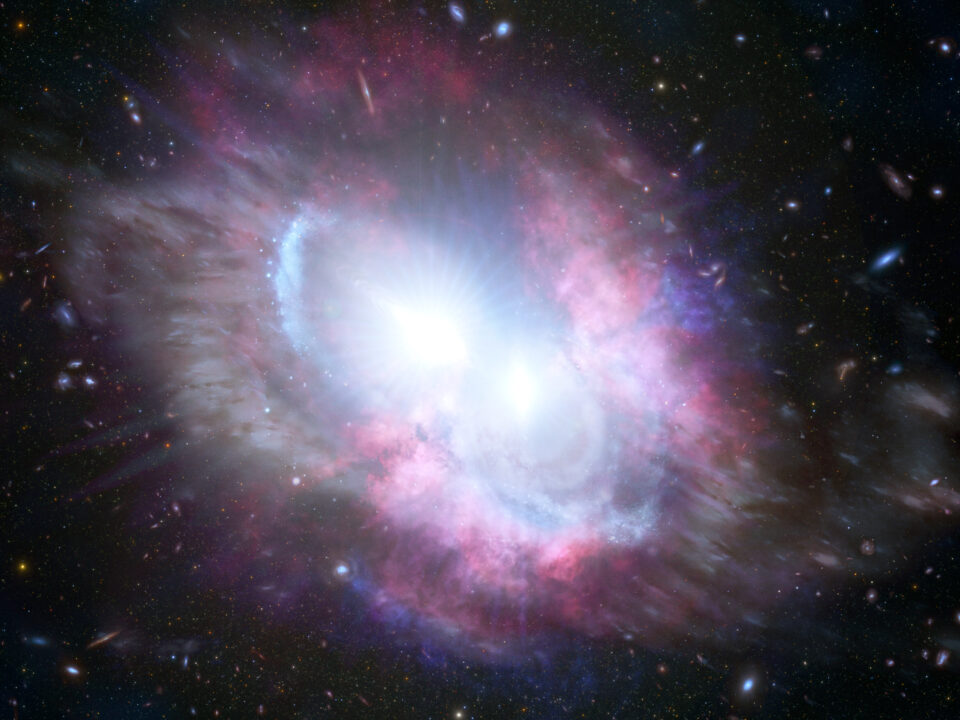Quasars are highly energetic sources powered by supermassive black holes, while kilonovae are the result of neutron star collisions. Each event releases vast amounts of energy into the universe.
Quasars emit powerful jets of radiation and matter from the center of galaxies, whereas kilonovae produce heavy elements such as gold and platinum. The distinct differences between quasars and kilonovae make them important phenomena in the study of astronomy and astrophysics.
Researchers closely analyze their properties to gain valuable insights into the nature of the universe and its evolution. Understanding the intricate processes behind quasars and kilonovae contributes to our broader knowledge of the cosmos and the phenomena that shape it.

Credit: www.space.com
What Are Quasars?
What are Quasars?
Quasars are incredibly bright and distant objects in space that emit massive amounts of energy. These celestial entities serve as beacons that shine light on the mysteries of the universe and play a crucial role in understanding the cosmos.
Definition Of Quasars
A quasar is a compact region at the center of a galaxy that emits intense electromagnetic radiation.
Characteristics Of Quasars
- Extremely luminous: Quasars are among the brightest objects in the universe.
- High redshift: They are often found in distant parts of the universe, indicating their early formation.
- Supermassive black holes: Quasars are powered by accretion onto supermassive black holes at their cores.
- Emission lines: Their spectra exhibit distinct emission lines due to high-energy processes within them.
Discovery Of Quasars
- 1960s: Quasars were first discovered in the 1960s through radio observations.
- Revolutionary findings: Their discovery reshaped astrophysics and our understanding of the cosmos.
- Ongoing research: Scientists continue to study quasars to unlock their secrets and unravel the mysteries of the universe.

Credit: www.maunakeaobservatories.org
What Are Kilonovas?
Kilonovas are catastrophic cosmic events that occur when two neutron stars or a neutron star and a black hole collide.
Definition Of Kilonovas
Kilonovas are extremely powerful explosions that release a vast amount of energy and produce heavy elements such as gold and platinum.
Characteristics Of Kilonovas
- Kilonovas are different from supernovas as they involve the merger of compact objects.
- Kilonovas emit a burst of gamma rays followed by a glow of infrared and ultraviolet light.
- Kilonovas are crucial for astronomers to study the origin of heavy elements in the universe.
Discovery Of Kilonovas
Kilonovas were first observed in 2017 using gravitational wave detectors and telescopes around the world.
Differences Between Quasars And Kilonovas
Quasars and kilonovas are fascinating astronomical phenomena, but they differ significantly in various aspects, including their size and energy output, formation mechanisms, and observational properties.
Size And Energy Output
Quasars are massive objects, typically found in the centers of galaxies, that emit tremendous amounts of energy. They are among the brightest and most energetic objects in the universe. In contrast, kilonovas are relatively smaller explosions that occur during the merger of two neutron stars or a neutron star and a black hole. They release a significant amount of energy, but not on the same massive scale as quasars.
Formation Mechanisms
The formation mechanisms of quasars and kilonovas differ greatly. Quasars are believed to be powered by the accretion of material onto a supermassive black hole at the center of a galaxy. As the material falls into the black hole, it produces immense energy. On the other hand, kilonovas are the result of the rapid merger of compact objects in space, such as neutron stars. During the merger, a bright burst of energy is released, generating the kilonova phenomenon.
Observational Properties
Quasars and kilonovas possess distinct observational properties. Quasars emit high-energy radiation across a broad range of wavelengths, including visible light, X-rays, and radio waves. They exhibit strong and variable emission lines, indicating the presence of superheated gas. In contrast, kilonovas produce a relatively brief burst of electromagnetic radiation, characterized by a combination of optical and infrared light. These emissions are typically seen after the gravitational wave signals produced by the merger event have been detected.
Similarities Between Quasars And Kilonovas
When it comes to the study of distant celestial phenomena, quasars and kilonovas are two fascinating objects that have captured the attention of astronomers and astrophysicists. Despite being different in nature, there are some intriguing similarities between these cosmic phenomena that are worth exploring.
Cosmic Collisions As A Common Factor
Both quasars and kilonovas are the result of powerful cosmic collisions involving massive bodies in space. Quasars are formed when supermassive black holes at the center of galaxies accrete mass from their surrounding environment, releasing immense amounts of energy in the process. On the other hand, kilonovas occur when neutron stars, which are the remnants of massive stars, collide and merge, leading to a brief but intense burst of energy and radiation.
Impact On The Surrounding Environment
Quasars and kilonovas have a profound impact on their surrounding environments. The violent processes that give rise to these phenomena also have significant implications for the galaxies in which they reside. Quasars, with their intense radiation and powerful jets, can influence the formation and evolution of galaxies, shaping the distribution of matter and affecting star formation. Similarly, kilonovas can contribute to the production and dispersal of heavy elements, such as gold and platinum, throughout the universe.
Scientific Significance
The scientific significance of Quasars and Kilonovae is profound as they provide valuable insights into the nature of the universe.
Contribution To Our Understanding Of The Universe
Quasars and Kilonovae play a crucial role in expanding our knowledge of the cosmos. They offer astronomers a unique opportunity to explore distant regions of the universe, shedding light on the formation and evolution of galaxies. These celestial phenomena enable researchers to probe the fundamental processes that govern the universe’s behavior, creating a deeper understanding of its underlying structure and dynamics.
Role In Studying Black Holes And Neutron Stars
Quasars and Kilonovae serve as invaluable tools for examining black holes and neutron stars, both of which are enigmatic cosmic entities. By studying the characteristics of quasars and kilonovae, scientists can gain valuable insights into the properties and behavior of these exotic objects. This research plays a pivotal role in advancing our comprehension of some of the most enigmatic and fascinating phenomena in the universe.

Credit: hubblesite.org
Observational Challenges
When it comes to studying celestial phenomena such as quasars and kilonovas, astronomers face numerous observational challenges. These challenges arise due to the elusive nature of these objects and the limitations of current technology in detecting and studying them. In this section, we will delve into the difficulties of detecting and studying quasars and kilonovas, as well as the impact of technological advancements in enhancing our understanding of these fascinating cosmic events.
Detecting And Studying Quasars
Detecting quasars, which are intensely bright and distant objects powered by supermassive black holes, poses a significant challenge for astronomers. Their extreme luminosity makes them visible across vast cosmic distances, but their small size and the presence of interstellar dust clouds can obscure their detection. Observing quasars can be like finding a needle in a haystack amidst a universe full of stars.
Moreover, studying quasars in detail is hindered by their immense distances from Earth. The light emitted by these cosmic powerhouses takes billions of years to reach us, which means we are essentially observing them in the distant past. This time delay makes it challenging to capture real-time observations and understand the present state of quasars.
However, technological advancements have revolutionized our ability to detect and study quasars. High-resolution imaging techniques coupled with advanced spectroscopy allow astronomers to pinpoint the unique spectral signatures of quasars. These signatures reveal valuable information about their composition, energy output, and motion. Additionally, space-based telescopes equipped with sensitive detectors and filters help to mitigate the effects of interstellar dust, enabling a clearer view of these distant cosmic powerhouses.
Detecting And Studying Kilonovas
The detection and study of kilonovas, which are short-lived and highly energetic explosions resulting from the merger of two neutron stars or a neutron star and a black hole, are equally challenging. These cosmic fireworks emit a wide range of electromagnetic radiation, including visible light, X-rays, and gamma-rays.
However, kilonovas are often overshadowed by other celestial events, and their observational characteristics overlap with other astrophysical phenomena. This complexity makes it difficult to distinguish kilonovas from supernovas, which are more common. Furthermore, kilonovas are relatively faint compared to quasars, making their detection even more challenging.
Technological advancements, including the development of sensitive detectors and advanced data analysis techniques, are instrumental in identifying and characterizing these elusive cosmic explosions. Improved telescopes, both ground-based and space-based, are now capable of detecting the faint signals of kilonovas across different wavelengths. By capturing and analyzing the distinct signatures of kilonovas, astronomers can gain insights into the physics behind these cataclysmic events and unravel the mysteries of the universe.
Impact Of Technological Advancements
Technological advancements play a pivotal role in overcoming the observational challenges posed by quasars and kilonovas. The constant evolution of telescopes, detectors, and data analysis techniques has revolutionized our ability to explore the cosmos.
Advanced telescopes equipped with adaptive optics enable us to obtain clearer images of distant quasars and kilonovas, surpassing the limitations imposed by Earth’s atmosphere. Moreover, space-based telescopes, such as the Hubble Space Telescope and the upcoming James Webb Space Telescope, provide unparalleled views of the universe, free from atmospheric distortions.
Additionally, the development of sophisticated detectors capable of detecting a broad range of electromagnetic radiation has expanded our observational capabilities. By capturing light across different wavelengths, these detectors allow astronomers to obtain comprehensive data about the properties and behaviors of quasars and kilonovas.
In conclusion, despite the observational challenges posed by quasars and kilonovas, technological advancements continue to push the boundaries of our understanding of these cosmic phenomena. With each new breakthrough, we enhance our ability to detect, study, and comprehend the mysteries of the universe.
Future Directions
Exploration of cosmic collisions: Scientists are delving into the mysteries of quasar and kilonova interactions to understand their impact on the universe. Through advanced technologies, they aim to uncover secrets hidden in these powerful cosmic events.
Advancements In Observational Techniques
- Telescopes with enhanced sensitivity
- High-resolution imaging tools
- Multi-wavelength observations
With these advancements, researchers can capture detailed data on quasars and kilonovae, paving the way for deeper insights into their nature.
Implications For Future Research
- Understanding cosmic evolution
- Probing the nature of dark matter and dark energy
- Unraveling the origins of heavy elements in the universe
Future studies will push the boundaries of knowledge, leading to breakthroughs in astrophysics and cosmology.
Frequently Asked Questions Of Quasar Vs Kilonova
What Is The Difference Between A Quasar And A Kilonova?
A quasar is a massive object powered by a black hole, emitting intense energy, whereas a kilonova is a celestial event resulting from the merger of two neutron stars, emitting gravitational waves and light.
How Are Quasars And Kilonovas Formed In Space?
Quasars are formed when supermassive black holes consume matter and emit energy, while kilonovas occur when two neutron stars merge, releasing energy in the form of gravitational waves and light.
What Are The Implications Of Studying Quasars And Kilonovas?
Studying quasars and kilonovas provides insights into the evolution of galaxies, black hole dynamics, and the formation of heavy elements in the universe, contributing to our understanding of cosmic phenomena and fundamental astrophysical processes.
Conclusion
Both quasars and kilonovas are fascinating astronomical phenomena that offer unique insights into the vastness and complexity of the universe. These celestial events continue to captivate astronomers and researchers, driving them to delve deeper into the mysteries of the cosmos.
By studying quasars and kilonovas, we can broaden our understanding of the formation and evolution of galaxies, as well as unlock invaluable knowledge about the origins of elements and cosmic phenomena. The ongoing discoveries in this field will undoubtedly lead to more exciting revelations in the future, allowing us to unravel the secrets of the universe.



